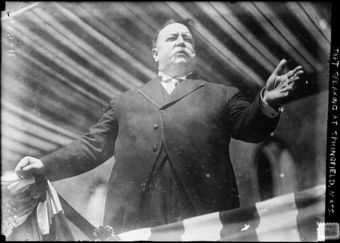3.1: Components of a Speech
3.1.1: Introduction
The introduction of your speech establishes your speech’s purpose, previews your key points and tells your audience why they should listen.
Learning Objective
Discuss why crafting a strong introduction is important when preparing a speech
Key Points
- Your introduction should immediately capture your audience’s attention and interest.
- Introduce yourself and who you are in your introduction to establish your credibility and authority to be speaking on your given subject.
- Your introduction should give your audience a preview of what they can expect to hear for the duration of your speech.
- When preparing your speech, it’s actually easier to write your introduction last, after you have written the rest of your speech.
- When preparing your speech, it’s actually easier to write your introduction last, after you have written the rest of your speech.
Key Terms
- audience
-
A group of people within hearing; specifically a group of people listening to a performance, speech etc.; the crowd seeing a stage performance.
- anecdote
-
An account or story which supports an argument, but which is not supported by scientific or statistical analysis.
Example
- In June 2005, Apple Computer CEO Steve Jobs gave the commencement address at Stanford University’s graduation. His introduction to his speech consisted of only six sentences and accomplished all of the key points to creating a solid introduction. Examine how each sentence fulfills all the key principles of crafting an effective speech introduction: “I am honored to be with you today at your commencement from one of the finest universities in the world. ” Jobs opens with a humble statement of gratitude while referencing his audience and the occasion. “I never graduated from college. Truth be told, this is the closest I’ve ever gotten to a college graduation. ” Jobs instantly becomes relatable to his audience by sharing a personal reference to the subject about which he intends to speak. “Today I want to tell you three stories from my life. That’s it. No big deal. Just three stories. ” Jobs clearly outlines how he has organized his speech and what his audience can expect. He also gives the audience a preview of how he will present his speech, using personal anecdotes. His attention-getter is in the simplicity of his speech outline.
Your Introduction: Set the Tone for Your Speech

Introduction
Aziza Brahim and Memona Mohamed during a press conference presentation of the movie “Wilaya” at the 10th Human Rights film festival in San Sebastian, Spain.
“Begin at the beginning. ” While this might be a line from the fantastical world of Lewis Carroll’s Alice in Wonderland, it’s an excellent piece of advice when thinking about the introduction to your speech. The introduction is the first part of your speech that will ultimately set the tone for the rest of your speech.
With the introduction, you have the power to capture your audience’s attention and interest while simultaneously giving them an understanding of what they’re about to hear for the next five, ten or even sixty minutes. An introduction can make or break a speech, because if you can’t capture your audience’s attention right at the beginning, how will they possibly remain interested for the duration of your speech?
Capture Your Audience’s Attention
When crafting your speech, you’ll want to select an attention-getter to use in your introduction to instantly capture your audience’s attention right from the beginning of your speech. There are a variety of attention-getting techniques you can use, including humor, sharing an anecdote or quotation, or referencing historical or current events.
Using references is a simple and effective way to grab your audience’s attention. You may make reference to the event at which you’re speaking or share a personal reference to the topic about which you’re speaking. It’s important to remember that you want to select an attention-getter that is appropriate to your topic, your audience and the venue or occasion at which you are speaking.
State Your Purpose
When beginning your speech and as you capture your audience’s attention, you’ll want to express exactly why they should listen to you. You may be giving a speech arguing a certain point. You might be giving an informational speech about a specific topic. Your speech could even be spoken at a special event such as an awards banquet, wedding or political event. Regardless of the context of your speech, it is important to establish the purpose of your speech to your audience so your audience knows why they should listen to you.
Your introduction is not just an introduction of about what you plan to speak, but an introduction of who you are and why you are the appropriate individual to speak about your subject. In some speeches, you may be preceded by someone who will introduce you to your audience. If not, it’s important to establish your credibility and authority as the speech-giver to your audience.
Outline Your Agenda
It is helpful for your audience to know about what you plan to speak. Use your introduction as an opportunity to share your train of thought with your audience. You don’t have to break your speech organization down into minute detail; that’s what the body of your speech will accomplish. Give your audience an overview of your main points so they have an idea of what to expect as your continue with your speech.
Writing Your Introduction
As counterintuitive as this may seem, you actually want to write your introduction last. Since the introduction is often used as an outline for the key points of your speech, it’s helpful to have written the entire speech to be able to distill your speech into its major points and arguments. Once you have your entire speech written minus your introduction, it’s much easier to see just which points emerge as your major points.
You’ll also want to make sure that you write your introduction word for word. While extemporaneous speeches don’t give you this kind of freedom, writing your introduction verbatim, or word for word, is vital for any prepared remarks. By writing it down word for word, you can quickly see if you’ve left out any of your major points as you set up your speech outline. You can also see if you have the right attention-getter suitable to your topic, audience and venue. Finally, since your introduction sets the tone for the rest of your speech, preparing it word for word allows you to begin your speech with confidence.

.President William Howard Taft introducing the Springfield Municipal Group in Springfield, Massachusetts.
Your introduction should immediately capture your audience’s attention and interest.
3.1.2: Body
The body of your speech is the point at which you go into full detail about each of your main points. The body is where you tell your story.
Learning Objective
Describe how to craft a strong body for a speech that entertains, informs, or argues a point
Key Points
- Organize your thoughts into a cohesive, logical flow of ideas.
- Each main point of your speech should support your speech’s purpose.
- Use a variety of examples to illustrate the main points of your speech, from research, facts and figures, to personal anecdotes and references.
- Don’t be afraid to let your personality come through; know your audience and tailor your approach accordingly. The body of your speech should be creative and engaging.
- Don’t stray too far from your outline; you will quickly lose your audience’s interest if you begin wandering off topic into points or anecdotes that don’t support your speech’s purpose or objective. You don’t want to appear disorganized or sound overly verbose.
Key Term
- brainstorming
-
A method of problem solving in which individuals or members of a group contribute ideas spontaneously.
Example
- Let’s say you have to write a speech on the rise of social media. Your professor wants you to argue a specific position about whether social media is beneficial or harmful to social interaction. After researching social media platforms, history, and applications, you decide to argue that social media is a beneficial tool. Your purpose is to persuade your audience that social media does more good than harm. You outline three main points: 1) that social media is popular and widespread; 2) that social media connects humans to one another faster than ever before; and 3) that social media often does social good. To illustrate your first point, you give a historical overview of the rise of social media while sharing facts, figures, and charts on social media’s growth and popularity. To explain your second point, you share anecdotes on how social media helped connect victims of natural disasters or crises to relief, aid, and real-time information. To support your third main point, you tell a personal story of how you contributed to a worthy charity after seeing a compelling viral video on Facebook promoting that charity’s efforts.
Your Speech Body: Deliver Your Main Points

Body of the Speech
Commander Naval Reserve Force Vice Adm. John G. Cotton is silhouetted in front of a Powerpoint slide, mapping out the Naval Reserve Force’s future.
Once you’ve captured the attention of your audience with an smashing introduction, it’s time to move into the meat-and-potatoes of your speech: the body. The body should take up about three-quarters of your entire speech time, since this is where you will go into detail about your main points.
Organize Your Content
Establish Your Purpose
Typically, there are three general reasons why you might be giving a speech: to entertain, to inform, or to argue a point. Each of these purposes requires a slightly different approach in order to successfully communicate its objectives to an audience. Once you’ve established your purpose, you can formulate a strategy for achieving that purpose with your main points. To illustrate each main point, you will need to use a series of examples.
Determine Your Main Points
Once you have your purpose established, it’s time to decide what main points you will use to achieve that purpose. You’ll want to start by brainstorming a list of all possible main points to support your purpose. Once you’ve completed this list, begin to assign them weights and priorities. Consider which points more effectively communicate your purpose than others. You may want to nest some points under others, thereby creating a natural hierarchy of main points and sub-points.
Equally important is determining exactly what does not belong in your speech or is irrelevant to your subject. Ultimately, you’ll want to boil down your main points to no more than three or four points. While this may seem minimalistic, know that your audience will only be able to remember so much, and you don’t want to overwhelm them with too much information. Three or four main points allow you to develop complete arguments in order to support your purpose, while still enabling your audience to follow your logic.
Decide How You Will Tell Your Story
You’ll want to have compelling evidence to support each main point of your speech. This evidence can be in the form of researched data, facts and figures, or even personal anecdotes and references. You may cite quotations and historical or current events to further bolster your arguments. Depending on your subject, audience and venue, humor may also be appropriate to weave throughout your speech.
If the purpose of your speech is to inform, you will rely heavily on data, statistics and research to illustrate your points. You may even use an accompanying presentation, video, chart, or images to help support your purpose.
If the purpose of your speech is to argue, you may find yourself using a combination of research and anecdotes to get your points across. You may also use accompanying media to illustrate your points; however, your data should be tailored to best argue your particular case. This is not to say that you should manipulate your data; rather, present only the information that your audience needs to see and hear to support whatever argument you are trying to make.
If the purpose of your speech is to entertain, you’ll rely more heavily on anecdotes than on hard research to get your points across. Humor is more than appropriate in this situation, but use it in moderation: you don’t want to jeopardize your credibility in front of your audience.
No matter the purpose or order of your main points, it’s important that you remember to stick to the outline of your speech. If you begin to wander off topic by sharing too many anecdotes, or presenting extraneous data, your audience may not be able to keep up and you will quickly begin to lose their interest.
Writing the Body
Once you’ve brainstormed and refined the main points of your speech, you can begin to write the body of your speech. The easiest strategy is to create an outline of your main points and list the supporting evidence you’ll provide for each main point. Depending on how comfortable you are with memorization, this may be all you need when you get up in front of your audience.
Many professional speakers do not rely on anything other than a brief outline of their speech, either memorizing what they plan to say in advance or simply speaking extemporaneously with only a basic guide. If this is one of your first speeches, and the situation allows, you may want to write your complete body word for word.
3.1.3: Conclusion
The conclusion of your speech summarizes your purpose and main points while leaving a lasting impression with your audience.
Learning Objective
Discuss the best practices for writing a strong conclusion for a speech
Key Points
- Use your conclusion as an opportunity to summarize the main points of your speech.
- Don’t repeat your main points word for word; rather, paraphrase the key themes and arguments you have just presented.
- Consider ending your speech with an additional anecdote or quotation that captures the theme of your speech.
- Don’t introduce any new points or supportive evidence into your conclusion as it will confuse your audience.
- Use trigger phrases such as “in conclusion” or “in summary” to prepare your audience for the end of your speech.
- Write your conclusion at the same time as the introduction (after you write the body) so that the introduction and conclusion complement one another.
Key Term
- summarize
-
To give a recapitulation of the salient facts; to recapitulate or review
Example
- On August 28, 1963, Dr. Martin Luther King, Jr. addressed hundreds of thousands of supporters in Washington D.C. about necessity of civil rights in America. Dr. King’s speech has often been recognized as one of the most memorable and important speeches of the twentieth century. What makes his speech so memorable is how he concluded it: “And when this happens, when we allow freedom to ring, when we let it ring from every village and every hamlet, from every state and every city, we will be able to speed up that day when all of God’s children, black men and white men, Jews and Gentiles, Protestants and Catholics, will be able to join hands and sing in the words of the old Negro spiritual: ‘Free at last! Free at last! Thank God Almighty, we are free at last! ‘” By using both a powerful call to action combined with the lyric of slave-era spiritual, Dr. King expressed his argument for civil rights with passion, emotion, and fervor.
Your Conclusion: Leave a Lasting Impression

Concluding Your Speech
The conclusion of your speech summarizes your main points and purpose while leaving a lasting impression on your audience.
If your body is the meat and potatoes of your speech, then the conclusion is the icing on the cake. Your conclusion is delivered at the end of the speech and is often what most people remember immediately after your speech has ended. As important as your introduction is for grabbing the audience’s attention, the conclusion is doubly important as it leaves the audience with a lasting impression.
Summarize Your Main Points
The purpose of the conclusion is to summarize your main points and to prepare the audience for the end of your speech. You’ll want to recapture the essence of your speech: your main points and the purpose of why you spoke. It is especially important to remember that the conclusion of your speech is not the time to introduce new points or new supporting evidence; doing so will only confuse the audience. Try to think of your conclusion like tying a bow or a ribbon: it’s the final touch that makes your project stand out.
Paraphrasing Versus Repeating
While summarizing your main points is important, be wary of simply repeating your main points word for word. You’ll want to paraphrase your main points rather than directly repeat them from your speech’s body. Paraphrasing allows you to capture the essence of your speech, unlike rote repetition of identical sentences you may have spoken just minutes earlier.
End on a High Note
Your conclusion is the last thing your audience hears from you. Just as an introduction can make or break a speech, you always want to end your speech on a high note with something memorable. The conclusion is where you’ll insert your take-away message: what do you want the audience to remember after you’ve finished speaking? What do you want them to recall in the days or weeks after your speech?
To create a memorable ending, you may want to share a quotation or anecdote. It’s important to remain relatable and credible to the audience up until your final word, so be sure to craft your conclusion in a way that is still appropriate to the topic, audience, and venue.
Writing Your Conclusion
Like the introduction, you’ll want to write your conclusion last. The introduction and conclusion of your speech serve as bookends to your speech’s body, so it only makes sense that you’ll want to craft them after you’ve written your body.
Review your speech’s body and ensure that you’ve touched upon all the main points you wish to discuss, then rephrase those main points in your conclusion. Determine the take-home message that you want to leave with your audience and either include it word for word in your conclusion or use it as a guiding theme for how you’ll end your speech. If you have any final anecdotes or quotations to share that either drive home a particular point or capture the theme of your speech, include it here.
While there is no set time or sentence limit for your conclusion, make sure you don’t finish your speech so suddenly that your audience is caught off guard when the speech ends. Using trigger phrases such as “in conclusion” or “in summary” signify to your audience that the speech is about to end and that they should pay special attention to your final thoughts.
3.1.4: Transitions
Transitions allow your speech to flow smoothly from one section or point to another.
Learning Objective
List the different types of transitions used in speeches
Key Points
- Transitions are used to show the linkage or connection between main points.
- Types of transitions include temporal, equality, causality, compare and contrast, and summary.
- After you determine the main points of your speech, order them logically and then determine how you will transition from one point to the next.
Key Terms
- segue
-
To make a smooth transition from one theme to another.
- transition
-
The process of change from one form, state, style, or place to another.
Transitions: Find the Right Flow of Ideas

Giving a Public Speech
Your speech should flow logically and smoothly from one point to the next.
As you craft your speech, you will need to transition from one point to the next to fully articulate your purpose or objectives. When read aloud, your speech should flow smoothly from introduction to body, from main point to main point and then finally into your conclusion. Transitions are essential in order to help your audience follow along your line of reasoning.
Types of Transitions
There are different types of transitions often used in speeches, including:
- Temporal- using words like before and after
- Equality-highlighting points of equal importance like in addition or moreover
- Causality- using words that show cause and effect
- Compare and Contrast- using words and phrases that compare one part of the speech to the next, like contrarily or on the other hand
- Introductions and summaries are also types of transitions to let listeners know what a person will be speaking about and offering a way to understand the important parts of a speech
The Art of the Segue
To move from one point and into the next, you’ll want to segue into your new point. Sometimes your points may share similar themes or concepts – order your points in such a way as to capitalize on those similarities. You can also use opposition to present opposing main points. If you have multiple pieces of supporting evidence, you may need to transition between examples so that your audience knows you are furthering a point with another example, anecdote or set of researched data.
However you decide to transition, you’ll want to use triggering keywords that let your audience know you’re moving on to a new point. Ordinal words like “next,” “second and “third” give your audience the heads up that you’re about to proceed in a new or continued direction of thought.
Writing Transitions
After you have identified your main points and outlined what evidence you’ll use to support them, begin to prioritize and sort your main points so they follow in the most logical order. From there, you’ll be able to pinpoint how you’ll want to transition your speech from one point to the next. Try to think of transitions as a way to connect the dots of your speech’s purpose.
3.2: Steps of Preparing a Speech
3.2.1: Choosing a Topic
When choosing your speech topic, brainstorm to generate many ideas, and distill those ideas to find your singular topic.
Learning Objective
Discuss different strategies for choosing a speech topic
Key Points
- Before you can begin writing your speech, you must first establish the main topic about which you plan to speak.
- Brainstorm early and often! You can try a variety of techniques to get your mental juices flowing, from clustering to free writing. Even just talking through your ideas with another person as a sounding board is a great way to get ideas.
- Once you start to get an idea of your topic, do a little preliminary research. See what others may have written or said about your general topic; reading their ideas may help give you some new ideas or directions of your own.
Key Terms
- topic
-
Subject; theme; a category or general area of interest.
- brainstorming
-
A method of problem solving in which individuals or members of a group contribute ideas spontaneously.
- distill
-
To extract the essence of; concentrate; purify.
Example
- Let’s say you need to write a speech related to the history of television. Using clustering as a brainstorming technique, write the word “television” in a central circle. From that, begin to write a few spokes shooting off from that main circle, such as “great moments in television history. ” From each of those spokes, add additional smaller spokes, such as “the moon landing,” “the rise of 24-hour news coverage cycle,” and “Star Trek: The Original Series shows the first interracial kiss” under your “great moments in television history” spoke. From there, begin to refine and hone your ideas. To guide how you want to build your argument, you may want to do a quick internet search to get a feel for what others have said about some of your final topic choices.
Choose Your Topic

Clustering
An example of an idea cluster for the subject “gardening.”
As you begin to prepare for any speech, it’s important to pin down exactly about what you plan to talk. You might have been given a specific topic by a professor or supervisor, or you may be simply invited to speak at an event where the topic is up to you. Knowing how to carefully select your topic is an important first step in preparing for a successful speech.
Start by thinking about your venue. Where will you be giving your speech? To whom will you be speaking? (We’ll get to analyzing your audience in the next section. ) Then, start to think about what you know about the topic, and move towards those subjects or tangents about which you don’t know. It’s helpful to speak about a topic with which you are already familiar, but sometimes you may be called into situations where you have no prior knowledge about a given subject.
In either instance, it’s helpful to approach your topic through brainstorming.
Brainstorming
One of the best ways to help solidify your speech topic is to brainstorm. You can brainstorm by yourself, or you might want to bring in a few friends, colleagues or classmates to help you come up with ideas in a group setting. You can brainstorm using a number of different exercises.
Word Association
Start with a broad topic idea. What words, topics, or other subjects do you associate with that first topic? Now what words, topics, or other subjects do you associate with the following word? Continue this chain of word association to give you a broad spectrum of ideas.
Clustering
Also known as mind-mapping, clustering gives your word association a visual form. Start with your main idea and draw a circle around it, thinking of it like the hub of a wheel. Now, begin to write other associated ideas, topics, or subcategories related to that main topic around the hub, and connect them as separate spokes. From each spoke, begin to jot down other associated ideas and thoughts. As your cluster begins to grow, you might want to connect smaller spokes to one another and create new links between subjects.
Freewriting
This is probably the simplest brainstorm method of all. Set a timer and begin writing whatever thoughts or ideas come to mind about your particular subject. You might find it easier to type your freewriting instead of writing it by hand, so you can keep up with your thoughts faster. Whatever you do, don’t stop writing.
Another way of freewriting is to record yourself talking for a set period of time and then transcribing your key points to go back to and clarify later. Once your time is up, go back and highlight or circle relevant points or topics that stick out for you. You’ll refine these later.
Distill Your Ideas into One Topic
Once you’ve brainstormed your many ideas, it’s time to refine your ideas and distill them into one topic. Look for themes, patterns, and commonalities when going through your brainstorming notes. Use these themes to help guide you toward a singular topic.
Do a Little Homework
While you will definitely research your topic, you might want to do some “presearch” – that is, a little research before the real research. Do a quick scan to see what others have said or written about your topic. This might give you even more ideas of how to refine and distill your topic, or more appropriately adapt it to your audience or venue.
3.2.2: Analyzing the Who, Why, and Where
Knowing and understanding your audience is one of the most important parts of developing an effective speech.
Learning Objective
Indicate the factors speakers should keep in mind when assessing their audience
Key Points
- Take into account the demographics of your audience: gender, age, industry, the event at which you’re speaking, common interests, culture and ethnicity, and how much they already may or may not know about your speech topic.
- Never stereotype your audience based on any of their demographics.
- Be mindful of gestures, colloquialisms, idioms, or other ethnocentric expressions (slang, mannerisms, etc. ) you might make during your speech. It’s important to recognize what is accepted in one culture may be offensive in another.
Key Terms
- ethnocentrism
-
The tendency to look at the world primarily from the perspective of one’s own culture.
- demographic
-
A demographic criterion: a characteristic used to classify people for statistical purposes, such as age, race, or gender.
- stereotype
-
A conventional, formulaic, and oversimplified conception, opinion, or image.
Example
- Remember, context is key. If you were speaking to a large audience composed mostly of men, you might think talking about pregnancy and women’s health would be inappropriate. But let’s assume that this audience is actually at an obstetrics conference, where these subjects would be more than appropriate. That’s why it’s imperative to do your homework about your audience.
Analyze Your Audience

Knowing the Audience
A speaker should consider the audience in order to craft an effective and successful speech.
Once you’ve established your topic, it’s time to focus on whom you’re speaking to. Next to identifying your topic, understanding your audience is one of the most important things you can do in preparing for your speech.
Understanding Your Demographics
Think about your audience: what do they look like? What might they have in common? What might you have in common with them? These are important things to consider as you begin to get a sense of just who will be sitting in front of you when you deliver your speech.
Consider the gender of your audience: male, female, or a mix? Are they older, younger? Would you consider them your peers? Have you met any of them before? Think about all the possible demographics of your audience including gender, age, national origin, ethnicity, culture, and occupation. But remember: just because you might be speaking to one group of people, that doesn’t mean you should stereotype that group. In fact, if you do end up stereotyping your audience, you’re more likely to lose them than engage them.
Also think about the knowledge that your audience brings to your presentation. They might be extremely well-versed in or they might not have the faintest idea about your topic. The more you can tailor your speech to your audience, the more effective and persuasive your speech will be.
Tempering Ethnocentrism
You should know that in any situation, you bring with you your own unique world-view and set of biases. You should especially be aware of your unique world-view and biases in your speech because they may negatively impact people of different cultures, ages, genders, etc.
The same goes for the use of gestures or mannerisms. Some everyday gestures may actually be offensive to other cultures. For example, at any Disney theme park, all the workers, when giving directions to tourists and visitors, always point with two fingers instead of one. Pointing a single finger in some cultures is considered extremely rude.
Some idioms and expressions that may seem natural and make sense to you may actually be quite confusing to people of different cultures or languages. Try to take a step back and consider the ethnocentric view you may be bringing to your audience and consider ways to minimize or temper those unique perspectives so as not to alienate your audience.
3.2.3: Topic Research: Gathering Materials and Evidence
In order to fully substantiate any claims you make in your speech, you must fully research those claims and provide supporting evidence.
Learning Objective
Discuss how to best research and gather supporting materials for a speech
Key Points
- Make sure you find credible sources of information, whether they be from scholarly sources that have been peer-reviewed, or irrefutable facts.
- There are many places you can go to research; while the internet might seem like the easiest place to find information, you always want to double check to make sure those sources are accurate and credible.
- Don’t use research that might be outdated, particularly with regard to scientific or technological advances.
- Make sure you acknowledge your sources. You may not directly reference them in your speech, but if questioned afterward, you’ll want to know from where you found your information.
- Never copy information word for word and claim it as your own; this is plagiarism and erodes the ethical integrity of you, your speech, and your reputation.
Key Term
- plagiarism
-
The act of plagiarizing: the copying of another person’s ideas, text or other creative work, and presenting it as one’s own, especially without permission.
Research and Gather Your Materials

Research
Make sure you research and gather enough evidence and supporting materials in order to talk about the topic
competently.
Now that you’ve figured out your topic and given some thought as to who will be your audience, it’s time to roll up your sleeves and begin the real work of preparing your speech. In this section, we’ll discuss how to best research and gather your materials and supporting evidence.
Finding Credible Sources
The first instinct for many people preparing a speech is to go out and find every piece of information they can, often via search engines online. While this is a great way to “presearch,” you’ll want to really pay attention to the sources from which you’re gathering your information. If you want to successfully substantiate any claim in your speech, you’ll need to make sure you back it up with information from credible sources.
Just What Makes a Source “Credible”?
Typically, hard, irrefutable facts make for a credible source. Fact: the Earth is anywhere from 36 to 63 million miles away from Mars, depending on orbital locations of either planet. But if you have a claim that could stray anywhere into the realm of opinion (such as, the existence of extraterrestrial life in the universe besides that on Earth), you’ll want to make sure you have credible sources to back up that claim.
Many times, you’ll want to turn to scholarly sources. Academic journals and publications (particularly if they have been peer-reviewed) make for excellent scholarly sources. Additionally, there’s no reason that you can’t approach an expert in the field that you are researching. In the latter instance, this is considered a primary source of information and can sometimes help point you in the right direction to find other credible sources of information.
When in doubt, ask your friendly librarian. They can often point you to online journal collections or academic search engines where you can find reliable, credible sources.
Keeping Your Research Organized
As you begin to assemble your research, it’s imperative to keep your notes centrally located and easily accessible. You might want to create a binder to keep all of your papers and notes together, or dedicate a multi-sectioned notebook to your research. You might take notes on notecards, organizing them by color or heading. If you take your notes online, you can use cloud computing to store your research remotely to access them anywhere on the go. Other software exists to keep your notes files and organized electronically on your computer.
Always keep records of where you got your information. You’ll need this in case someone ever decides to question you about your facts after your speech. Also, this shows people that, yes, you’ve done your homework. Additionally, you should never copy any information word for word and claim it as your own. Plagiarism will only damage your reputation and the credibility and ethics of your speech in addition to potentially causing you to fail a class, lose your job, or worse.
However you organize your notes, just make sure you have them organized and handy. You never know when you might run into a primary source!
3.2.4: Developing Your Thesis
All speeches must have a point or a main argument – a thesis.
Learning Objective
Illustrate the best approach for developing a thesis for a speech
Key Points
- The main argument of your speech is your thesis statement: what case are you trying to make?
- If you are arguing for or against a certain idea, belief or topic, you must provide compelling evidence to support your position.
- When crafting your thesis statement, consider potential arguments, questions, or concerns someone with an opposing viewpoint may have. This process helps you develop a more robust thesis.
Key Terms
- thesis statement
-
A thesis statement summarizes a speech’s argument in one to three sentences.
- rebut
-
To deny the truth of something, especially by presenting arguments that disprove it.
Example
- Imagine you were writing a speech arguing which came first: the chicken or the egg? You take the position that the egg came first as your thesis statement. You would need to make a compelling to explain exactly why you believe the egg came first: perhaps you have data, statistics or other research to back up your claims. As invested as you might be in your thesis, don’t forget to consider the opposition. A “chicken first” believer would argue that it would be impossible for an egg to have come first, because it could not have gotten there without the chicken. Be prepared to rebut the other side.
Developing Your Thesis

Thesis
A painting depicting a lecture in a knight academy in the 1620s.
In some circumstances, you will most likely be arguing some kind of point or message in your speech. The main argument of your speech – the main point you want your audience to understand – is the thesis of your speech.
The Thesis Statement
In any opinion piece, written or spoken, the main argument – the thesis statement – comes at the beginning. You want your audience to know right away the point you are trying to make. It is important to remember that your thesis statement only addresses one main issue; the ways in which you choose to support your thesis add complexity and depth to your speech.
Arriving at Your Thesis
When composing your thesis statement, consider and answer the following questions:
- How do you feel about your topic?
- How does your audience generally feel about your topic?
- What do you want your audience to feel or believe about your topic?
- What other opinions have been said/written about your topic?
- Are you arguing for or against your topic?
- What social issues factor into your topic?
- What is your topic’s influence on the individual, a particular community or society as a whole?
As you begin to answer these questions, start thinking about ways you want to support your thesis with compelling, persuasive examples.
Playing Devil’s Advocate
No matter how you choose to argue your point, it is important to take a step back and play devil’s advocate; that is, take a look at your argument from that of the opposing viewpoint. By considering all sides of your argument, you will bolster your case by preparing for all possible objections and rebuttals to the claims you intend to make in your speech.
3.2.5: Supporting Your Ideas
Use a variety of ways to support the ideas and claims that you make with your thesis statement to give your speech depth and dynamics.
Learning Objective
Explain how to use ideas and examples to back up claims in a speech
Key Points
- Set the stage for how you plan to address your argument and make your case by laying out the exposition of your argument.
- Appeal to your audience’s core beliefs, goals or common interests to influence your audience by persuasion.
- If you are speaking to a sympathetic crowd, consider influencing your audience by suggestion or popular sentiment on your given topic.
- Use personal narratives and anecdotes to make your case if appropriate to your audience, topic, and speech venue.
- If your idea is complex, consider breaking it down into simpler parts to more thoroughly and easily describe your idea. Help your audience to visualize your points by articulately describing them.
Key Terms
- exposition
-
The act of declaring or describing something through either speech or writing.
- anecdote
-
An account or story which supports an argument, but which is not supported by scientific or statistical analysis.
Example
- Let’s say you have to give a speech about civil rights in America and how your audience must take active roles in protecting their own civil rights as well as the rights of others. You might begin by laying out a foundational overview of the historical timeline of civil rights since America’s independence in 1776. Persuade your audience by sharing compelling examples of how civil rights have been violated across many groups: gender, race, religion. These broad appeals are sure to resonate with many different members of your audience. You may also provide examples that all get back to your same idea: infringing upon any civil rights by any group to any group is wrong. You might share how a relative was involved in the Mississippi riots in the 1960s or how your mother was involved in the Women’s Liberation movement in the 1970s. Finally, walk the audience through the basic principles of your argument about how the infringement of civil rights for one group can ultimately lead to the infringement of civil rights for all.
Supporting Your Ideas

Preparing Supporting Ideas and Materials
It’s important to select the right evidence and supporting materials to help you establish the main points in your speech.
Once you have solidified your position in your thesis statement, you want to back up your thesis with a variety of supporting ideas and examples. To do this, there are several ways you can support your claims while adding variety and interest to the overall story of your speech.
Set the Stage
Using exposition is a great way to get your audience all on the same playing field. When you use an expository approach, you’re carefully laying out all of the background information your audience needs to know in order to understand your point.
Appeal to Commonalities
As you notice commonalties between audience members, the audience and your topic, and you and your audience, appeal to those commonalities to not only establish rapport but also to more easily persuade them to your thesis and claims. Your audience is more likely to trust and believe you if they feel they share something in common with you and your topic.
Finding a Consensus
Your audience may already feel a certain way about your topic. Depending on what you’re trying to argue, you may want to go ahead and appeal to that consensus. Just be careful: you don’t want to bore your audience by “preaching to the choir. “
Tell a Story
One of the best ways to back up your claims–besides cold, hard, facts and data–is to share a personal story or anecdote. This shows your audience that you really connect to your subject, making you more believable and personable. Using anecdotes are a perfect opportunity to lighten the mood and add some humor as appropriate to your speech.
Deconstruct Your Topic
You might have a particularly complex subject or thesis. In these instances, it’s helpful to break it down into its simplest parts. By breaking your information down into bite-sized chunks, your audience may have an easier time of following your train of thought or logic.
3.2.6: Organizing and Outlining the Speech
Arrange your speech – your thesis, additional points, and supporting evidence – in a way that will make sense to your audience.
Learning Objective
Discuss best practices for organizing notes and research into one speech
Key Points
- To organize your thoughts, consider giving each point or supporting evidence its own note card. Begin to arrange them according to importance and your main points will begin to emerge.
- Outlines typically begin with your thesis and end with any concluding thoughts.
- Depending on your topic or thesis, arranging your points chronologically is an effective way to establish a timeline of your argument.
- If giving an informational speech, you might describe your subject as parts of an object, outlining each part or section.
- You can move from broad points to specific points, or vice versa, depending on the effect you are trying to achieve and the argument you are trying to make.
Key Terms
- thesis
-
A concise summary of the argument or main points, usually one to three sentences long.
- chronological
-
In order of time from the earliest to the latest
Example
- When giving a speech on the history of television, you might organize your points chronologically by starting with the invention of motion pictures, to the invention of the television, through to modern internet streaming video today.
Organizing and Outlining Your Speech
Now that you have decided on your topic, analyzed your audience, arrived at your thesis, and determined how you will support your claims, it is time to organize your notes and research into one coherent speech.
You did keep all of your notes centrally collected and easily accessible, right? If you put all of your research notes and thoughts onto notecards, it is particularly helpful to lay them out in front of you and begin to organize your points and sub-points in ways that make the most logical sense.

Organizing Your Ideas
It’s important to develop an outline and clearly explain your ideas.
What are some ways to establish logical order?
Establish a Timeline
Depending on your subject and the point you are attempting to make, it might make sense to order your research and points in chronological order. If you are giving a speech on the rise and fall of the Roman Empire, it makes sense to start with its rise, and end with its fall. Outlining your speech as a series of chronological events or points allows your audience to follow along a linear timeline for easy understanding of your subject matter.
Your Thesis as the Sum of Its Parts
Think of your thesis like a machine. Each claim is another cog, each example or supporting evidence another lever in that machine, all working together to arrive at the same persuasive conclusion. Sometimes it is helpful to break up your thesis into each of these smaller parts, to make the information more easily digestible for your audience.
The Broad and the Specific
Building on the idea of your thesis as machine, you may present your overall, broad idea, then break it down into smaller, logical steps to reach that big idea. Conversely, you may start with smaller ideas and expand into the bigger, broader idea. When constructing your arguments from smaller ideas, you are more likely to drive your point home with a broad, sweeping finish. On the other hand, you can dilute the complexity of a broad idea by breaking it down into smaller, logical pieces of information.
A Sample Outline
Here is a sample outline about issues of feminism in William Shakespeare’s Hamlet:
I. Introduction and Thesis: Brief description of issues that arise when reading “Hamlet”
II. Issues of feminism uncovered through reading “Hamlet”
a. What other scholars have discovered about feminism in “Hamlet”
b. Which of these discoveries was most evident
c. Ideas of feminism I uncovered on my own
III. How uncovering ideas of feminism in “Hamlet” has led me to better understand what Shakespeare thought of the role women played in society
IV. Conclusion
3.2.7: Wording the Speech
A good speech is not written in one sitting; write multiple drafts, then review and edit before settling on a final text.
Learning Objective
Discuss tips and tricks for drafting a speech
Key Points
- Use the ABC approach to begin your first draft. The Abstract explains your thesis. The Body features your main points and supporting evidence. The Conclusion contains your final thoughts and reiterates your point.
- Make sure to have all of your notes and research close by and easily accessible so you can turn to your sources as often as you need to while your draft your speech.
- Editing and revising are not the same thing. To edit, review your speech for changes. To revise, actually implement those changes. Editing and revising are cyclical in nature as you continue to hone your draft.
- If on your first draft you find yourself going off on a tangent, allow yourself to follow it. You can always edit, revise and remove sections later that are wordy or off-topic.
- Writer’s block can happen to even the best writers. Take a break for a few minutes and come back to your speech renewed and refreshed. But don’t stay away too long or you might lose your momentum.
Key Terms
- writer’s block
-
The inability to begin or continue work on a piece of writing; normally temporary.
- eloquence
-
The quality of artistry and persuasiveness in speech or writing.
- abstract
-
Difficult to understand; abstruse.
Find the Right Wording for Your Speech

Drafting Your Speech
Handwritten speech notes by President Ronald Reagan
The art of public speaking comes from the eloquence of the speaker. While researching your subject and outlining your speech may seem like the most time-consuming aspect of preparation, taking the time to write your speech can actually take the most time to complete.
Writing Your First Draft
When you begin writing your speech, don’t assume what you write now will be the final version of your speech. A draft is simply your first pass at what you plan to say. Using your outline as a guide, refer to your organized research notes (that you’ve centrally collected and have easily accessible for just such an occasion, right? ) to begin to flesh out your speech.
It is helpful to take an ABC approach to writing your speech. Introduce your subject and thesis in an Abstract, or introduction, section. This abstract gives a general summary about what you plan to speak. Then write your Body, where you will make and substantiate claims to support and argue your thesis. Finally, write your Conclusion, tying it all together in one memorable finish.
You may find that you start to veer off-topic as you begin to write your speech. You will have time to go back and prune later; for now, the focus is to keep writing.
Refine, Refine, Refine: Editing and Revising
Now that you have written the first draft, reread what you have written to refine your wording.
Editing
Read through your first draft. Look for typos such as spelling and grammatical errors. Also look for awkward phrasing or parts of speech. Read sections aloud: do they make sense? If so, reword those sections.
Consider the vocabulary you are using: Is it appropriate? Are you potentially using language that may go over your audience’s heads, or perhaps is too elementary? Consider your tone, style and verbiage. Also consider the structure of your argument: does your speech actually make sense?
It is helpful to give your first draft to another person to review and edit, as it helps to have a fresh set of eyes look at your material.
Revising
Once edits have been made, implement those suggestions and changes to your draft. When you begin revising, you may find that you are making more changes along the way and may write multiple drafts. The editing and revising process becomes a cycle of newer drafts. Eventually, the revisions will be done and you will have settled on your final draft.
Dealing with Writer’s Block
Have you ever sat down in front of your computer, a blank document open, the cursor just blinking at you…and no words come to your brain? Don’t panic! It is a harrowing moment for any writer, but don’t be alarmed: writer’s block is perfectly natural and there are ways to overcome it.
Some tackle writer’s block by forcing themselves to write anything, as long as they keep writing. You can set a timer and commit to keep writing without stopping until that timer ends. Hopefully, that will be enough of a boost to get your writer’s juices flowing.
If not, walk away from your speech for a little while. Sometimes it is good to clear your mind from a subject in which you are thoroughly engrossed in order to gain a fresh perspective.
When in doubt, two heads are better than one. Call up a friend, colleague, or classmate and share ideas with them. They just might have the inspiration and outside perspective you need to get your hands flying across your keyboard in no time.
3.2.8: Preparing to Present
Practice makes perfect!
Learning Objective
Discuss the different methods for preparing for and presenting a speech
Key Points
- Determine how you will present your speech: will you read it verbatim, memorize it, or read from an outline of notes?
- Reading verbatim has both its positives and negatives. On the plus side, you’ll have your entire speech written out in front of you; however, these types of speeches tend to feel a bit stilted to audience members.
- Memorizing your speech can seem like a weighty task, but it allows you to retain all of your key points and wording while still appearing natural and effortless to your audience. It frees you from having to read right off of a manuscript.
- When speaking extemporaneously, you can have a rough outline of your notes. You might have this on a single sheet or perhaps across several notecards. In either case, these serve as reminders about your topic, your points and in what order they should be shared.
- If you’re nervous about presenting in front of a group of people for the first time, work out your nerves by asking a small group of friends or colleagues to be your test audience. Your test audience can give you immediate feedback on what you did well and how you could improve.
- Ever wonder what you look like while giving a speech? Practice in front of a mirror, or better yet: record yourself. You’ll be able to see if you have any unconscious gestures or habits that you can correct or prevent as you feel them happening.
Key Terms
- extemporaneous
-
A type of speech delivery which involves preparation of speaker notes prior to delivery, associated with conversational style of delivery.
- verbatim
-
A word-for-word report of a speech.
Example
- There’s a famous old joke: how do you get to Carnegie Hall? Practice! There’s a lot of truth to be found in that old adage. The more you can give your time to practice and rehearse your speech, the more comfortable you’ll be. You might feel nervous for your first few speeches but over time and with experience, those nerves will fade. That said, you don’t want to rehearse so much that your speech feels robotic or rote. You should appear natural and comfortable in front of your audience, whether it’s your first speech or your fiftieth.
Prepare to Present

Practicing Your Speech
Take the time you need to rehearse and prepare your speech before getting up in front of your audience.
You’ve written your speech: congrats! Now it’s time to work on just how you plan to present your speech and prepare it accordingly. First, decide how you’ll present your speech: will you read your newly minted speech verbatim from script? Or will you memorize it? Or will you simple read off an outline or notes?
Reading Your Speech Word for Word
For your first speech, it might be helpful to have it completely typed up and ready for you to read verbatim in front of a crowd. You may feel more confident having your exact wording in place assembled right there in front of you.
Reading verbatim from a script has its drawbacks; you may be limited in how much eye contact you can engage in with your audience. As such, your audience may more quickly disconnect from your words and you as speaker. Additionally, speeches read straight from a script or manuscript often feel stodgy and stilted, which is a sure way to bore your audience and lose their attention fast.
Memorizing Your Speech
You can memorize your speech in the same way that you might memorize lines or a monologue for a theatrical play. By freeing yourself from reading off a sheet or many sheets of paper, you lose some of the rigidity that comes with reading a speech off a script. There’s less for your hands to fumble with, allowing you to take a more open body position as you deliver your speech, making you more engaging with your audience.
However, one of the biggest disadvantages to memorizing a speech can be unexpected stage fright where you might clam up entirely, unable to remember your speech. It never hurts to have a copy of your speech on hand when you plan on memorizing your speech.
Speaking Extemporaneously from Notes
The middle ground between reading from script and memorizing your speech is to read from notes. By preparing an outline or a few note cards with keys points in the order you plan to present them, you have the freedom to have open body posture with a safety net of reference. Speaking from notes sometimes involves keeping your hands busy holding the notes and it does draw your eye contact periodically away from the audience. The tradeoff is worthwhile because it allows you to have an engaging stance combined with an outline of your speech.
Dealing with Nerves
It’s completely normal to be nervous about giving your first speech in front of a large group of people. Even world leaders get butterflies in their stomach before addressing the world stage. To help combat your fears, just remember: if you flub your speech it’s probably not going to kill you, so why stress?
You can also ease your fears by taking the time to practice frequently. Read your speech out loud so you begin to develop muscle memory around your phrases and sentences. You can even read your speech in front of trusted friends or colleagues. By practicing in front of a smaller group, you can take the edge off having to present in front of a larger group. Additionally, having your friends as the test audience will give them an opportunity to provide you with valuable feedback about what you’re doing well and where you need to improve.
If you’re not sure what you look like while speaking, practice in front of a mirror. Better yet, record yourself and play back the recording a few times to yourself. Watching yourself speak is another great way to help calm your nerves and break the tension while discovering subtle facial movements or body language that might actually hurt your speech.
3.2.9: Delivering the Speech
Details like how you dress, enunciate, and use body language can be just as important as what you say.
Learning Objective
Give examples of tactics speakers can use to deliver a speech effectively
Key Points
- Make sure you dress to impress. While some speeches may be delivered in a casual setting, you want to make sure you’re wearing clothing appropriate to the dress code of your event.
- Be aware of your body language. A closed body position (arms crossed, shoulders hunched) and lack of eye contact will make it extremely difficult for your audience to engage with you.
- Engage your audience by making eye contact with them. If making eye contact wigs you out, you can always look just above their heads to give the same effect.
- Stand up straight, remember to breathe, and limit your “um”s, “uh”s, and “like”s. Use whole phrases like “should have” instead of “shoulda. ” Avoid slang or profanity.
- Have a backup plan in case equipment fails for things such as visual aids, PowerPoint presentations, or teleprompters.
Key Term
- body language
-
Body language is a form of mental and physical ability of human non-verbal communication. It consists of body posture, gestures, facial expressions, and eye movements. Humans send and interpret such signals almost entirely subconsciously.
Delivering Your Speech

Delivering a Speech
A woman delivers a speech at a TEDx event.
The big day has arrived: it’s time to present your speech! Besides remaining calm and speaking clearly and at a loud enough volume, here are the most important things to consider as you present your speech.
Dress to Impress
The way you look as you give your speech is almost as important as the words coming out of your mouth. It’s imperative to know the dress code for the event at which you’re speaking. If you’re the best man at your best friend’s wedding, you will probably be wearing a tux. Unless of course it’s a beach wedding, when flip flops and shorts could be totally appropriate.
In a business setting, men should wear a button-down shirt and dress pants and shoes; depending on how formal the business setting, this may also include a suit jacket and tie. Women should wear a dress, dress pants or skirt with a button-down top, blazer, blouse or nice sweater. Shoes can be heels or flats and should be appropriate to your setting.
For men and women, it’s also helpful to consider how long your speech is and if you’re expected to stand for the duration of your speech when determining appropriate yet comfortable footwear.
Watch Your Body Language
In the same vein that how you look is almost as important as what you say, how you stand can be just as important as your words. Humans pick up subtle cues with regard to emotion through non-verbal communications in body language. When delivering your speech, you want to make sure you have a confident, open stance to convey your confidence. Standing hunched over or with your arms crossed will close off your body to your audience, thereby shutting them out.
Similarly, make eye contact with your audience. Sometimes this makes speakers nervous, but it’s an important technique to really connect with your audience. If the idea of making direct contact makes you uncomfortable, you can always scan your view around the room looking just above your audience’s heads; it achieves the same connective effect.
Finally, if you can move around, do. It builds visual interest for your audience and also helps you to work out jitters if you have them. You might be confined behind a podium or lectern, in which case your largest range of motion may be restricted to hand gestures and your gaze around the room. If you can walk out from behind a podium and across a stage, take the opportunity. Just don’t wander, watch where you step, and try not to make your audience motion sick by walking back and forth too much.
Articulate and Enunciate
Speak your words clearly. Don’t rush your sentences or let the ends of your sentences drop in volume. You’ve worked this hard to write and prepare your speech–you want to make sure your audience understands what you have to say.
Avoid saying “um”, “uh”, or “like” (when it doesn’t belong in a sentence). These are usually nervous habits that take time to break. If you feel an “um” coming on, simply pause for a brief moment before moving past it. Additionally, don’t be afraid of silence when you’re making a dramatic or compelling point. And sometimes, be prepared for your audience to interrupt you with clapping or laughing. You might need to stop a sentence to let the audience do its thing while you resume as it dies down.
Have a Backup Plan
If you have supplementary materials such as visual aids or a PowerPoint presentation, have a backup plan in place in case some piece of equipment doesn’t work. You may want to have printouts just in case a computer or projector doesn’t work.
Similarly, if you’ve memorized your speech or may be reading from a teleprompter, have a printed copy of your speech or an outline of your speech on hand just in case you get a case of stage fright or equipment fails.
One More Thing
Before you walk off that stage or sit back down in your seat, always thank your audience.
